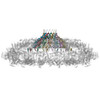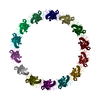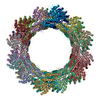+ Open data
Open data
- Basic information
Basic information
| Entry | Database: PDB / ID: 6oeg | |||||||||||||||
|---|---|---|---|---|---|---|---|---|---|---|---|---|---|---|---|---|
| Title | Structure of CagX from a cryo-EM reconstruction of a T4SS | |||||||||||||||
 Components Components | Type IV secretion system apparatus protein CagX | |||||||||||||||
 Keywords Keywords | TRANSLOCASE / T4SS / Secretion / H. pylori | |||||||||||||||
| Function / homology | Type IV secretion system CagX conjugation protein / Conjugal transfer, TrbG/VirB9/CagX / VirB9/CagX/TrbG, C-terminal / VirB9/CagX/TrbG, C-terminal domain superfamily / Conjugal transfer protein / Type IV secretion system apparatus protein CagX Function and homology information Function and homology information | |||||||||||||||
| Biological species |  | |||||||||||||||
| Method | ELECTRON MICROSCOPY / single particle reconstruction / cryo EM / Resolution: 3.8 Å | |||||||||||||||
 Authors Authors | Chung, J.M. / Sheedlo, M.J. / Campbell, A. / Sawhney, N. / Frick-Cheng, A.E. / Lacy, D.B. / Cover, T.L. / Ohi, M.D. | |||||||||||||||
| Funding support |  United States, 4items United States, 4items
| |||||||||||||||
 Citation Citation |  Journal: Elife / Year: 2019 Journal: Elife / Year: 2019Title: Structure of the Cag type IV secretion system. Authors: Jeong Min Chung / Michael J Sheedlo / Anne M Campbell / Neha Sawhney / Arwen E Frick-Cheng / Dana Borden Lacy / Timothy L Cover / Melanie D Ohi /  Abstract: Bacterial type IV secretion systems (T4SSs) are molecular machines that can mediate interbacterial DNA transfer through conjugation and delivery of effector molecules into host cells. The Cag T4SS ...Bacterial type IV secretion systems (T4SSs) are molecular machines that can mediate interbacterial DNA transfer through conjugation and delivery of effector molecules into host cells. The Cag T4SS translocates CagA, a bacterial oncoprotein, into gastric cells, contributing to gastric cancer pathogenesis. We report the structure of a membrane-spanning Cag T4SS assembly, which we describe as three sub-assemblies: a 14-fold symmetric outer membrane core complex (OMCC), 17-fold symmetric periplasmic ring complex (PRC), and central stalk. Features that differ markedly from those of prototypical T4SSs include an expanded OMCC and unexpected symmetry mismatch between the OMCC and PRC. This structure is one of the largest bacterial secretion system assemblies ever reported and illustrates the remarkable structural diversity that exists among bacterial T4SSs. | |||||||||||||||
| History |
|
- Structure visualization
Structure visualization
| Movie |
 Movie viewer Movie viewer |
|---|---|
| Structure viewer | Molecule:  Molmil Molmil Jmol/JSmol Jmol/JSmol |
- Downloads & links
Downloads & links
- Download
Download
| PDBx/mmCIF format |  6oeg.cif.gz 6oeg.cif.gz | 460.5 KB | Display |  PDBx/mmCIF format PDBx/mmCIF format |
|---|---|---|---|---|
| PDB format |  pdb6oeg.ent.gz pdb6oeg.ent.gz | 353.4 KB | Display |  PDB format PDB format |
| PDBx/mmJSON format |  6oeg.json.gz 6oeg.json.gz | Tree view |  PDBx/mmJSON format PDBx/mmJSON format | |
| Others |  Other downloads Other downloads |
-Validation report
| Summary document |  6oeg_validation.pdf.gz 6oeg_validation.pdf.gz | 1.1 MB | Display |  wwPDB validaton report wwPDB validaton report |
|---|---|---|---|---|
| Full document |  6oeg_full_validation.pdf.gz 6oeg_full_validation.pdf.gz | 1.1 MB | Display | |
| Data in XML |  6oeg_validation.xml.gz 6oeg_validation.xml.gz | 70.9 KB | Display | |
| Data in CIF |  6oeg_validation.cif.gz 6oeg_validation.cif.gz | 92.2 KB | Display | |
| Arichive directory |  https://data.pdbj.org/pub/pdb/validation_reports/oe/6oeg https://data.pdbj.org/pub/pdb/validation_reports/oe/6oeg ftp://data.pdbj.org/pub/pdb/validation_reports/oe/6oeg ftp://data.pdbj.org/pub/pdb/validation_reports/oe/6oeg | HTTPS FTP |
-Related structure data
| Related structure data |  20020MC  6odiC  6odjC  6oeeC  6oefC  6oehC M: map data used to model this data C: citing same article ( |
|---|---|
| Similar structure data |
- Links
Links
- Assembly
Assembly
| Deposited unit | 
|
|---|---|
| 1 |
|
- Components
Components
| #1: Protein | Mass: 60720.480 Da / Num. of mol.: 14 / Source method: isolated from a natural source / Source: (natural)  |
|---|
-Experimental details
-Experiment
| Experiment | Method: ELECTRON MICROSCOPY |
|---|---|
| EM experiment | Aggregation state: PARTICLE / 3D reconstruction method: single particle reconstruction |
- Sample preparation
Sample preparation
| Component | Name: Type IV secretion system apparatus protein CagX / Type: COMPLEX / Entity ID: all / Source: NATURAL |
|---|---|
| Source (natural) | Organism:  |
| Buffer solution | pH: 7 |
| Specimen | Embedding applied: NO / Shadowing applied: NO / Staining applied: NO / Vitrification applied: YES |
| Specimen support | Details: unspecified |
| Vitrification | Cryogen name: ETHANE |
- Electron microscopy imaging
Electron microscopy imaging
| Experimental equipment |  Model: Titan Krios / Image courtesy: FEI Company |
|---|---|
| Microscopy | Model: FEI TITAN KRIOS |
| Electron gun | Electron source:  FIELD EMISSION GUN / Accelerating voltage: 300 kV / Illumination mode: FLOOD BEAM FIELD EMISSION GUN / Accelerating voltage: 300 kV / Illumination mode: FLOOD BEAM |
| Electron lens | Mode: BRIGHT FIELD |
| Image recording | Electron dose: 59.2 e/Å2 / Film or detector model: GATAN K2 SUMMIT (4k x 4k) |
- Processing
Processing
| EM software |
| |||||||||||||||
|---|---|---|---|---|---|---|---|---|---|---|---|---|---|---|---|---|
| CTF correction | Type: PHASE FLIPPING AND AMPLITUDE CORRECTION | |||||||||||||||
| Particle selection | Num. of particles selected: 24662 | |||||||||||||||
| Symmetry | Point symmetry: C14 (14 fold cyclic) | |||||||||||||||
| 3D reconstruction | Resolution: 3.8 Å / Resolution method: FSC 0.143 CUT-OFF / Num. of particles: 17159 / Symmetry type: POINT | |||||||||||||||
| Atomic model building | B value: 78.29 |
 Movie
Movie Controller
Controller








 PDBj
PDBj